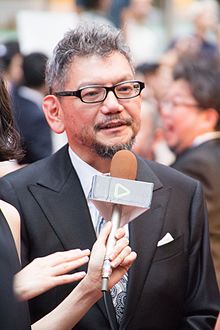Neon Genesis Evangelion (franchise)
[9][10] The Neon Genesis Evangelion manga debuted in Shōnen Ace in December 1994, to generate interest in the upcoming anime release.[12] General consensus is that the anime was groundbreaking[13][14] in its exploration of religious,[15] psychological,[16] and philosophical[17] themes, while initially appearing to be a standard mecha show.[21] The popularity of the show spawned numerous additional media, including video games,[22] radio dramas,[23] audio books,[24] a light novel series,[25] pachinko machines,[26] and a tetralogy of films titled Rebuild of Evangelion.[27] Other derivative works include Angelic Days,[28] Petit Eva: Evangelion@School[29] and Shinji Ikari Raising Project.[30] Works within the Neon Genesis Evangelion franchise typically have the same setting, characters, and themes, but can vary in their portrayal of the different storylines with alternate re-tellings of the original anime.[32] Evangelion's fictional setting takes place after the Second Impact, a cataclysmic explosion in Antarctica in the year 2000,[33] which killed billions of people and threw the Earth off its axis.[34] Fifteen years after the Second Impact, a group of mysterious beings referred to as "Angels"[35] begin appearing and pose a worldwide and existential threat to what remains of mankind.The NERV organization, a paramilitary special agency recruited and controlled by the UN, is tasked with defeating the Angels,[36] with the use of giant mechanical warriors known as "Evangelions".[37] A select group of children pilot the Evangelions, with focus put on Shinji Ikari, Rei Ayanami and Asuka Langley Soryu.[42][43] This is most heavily covered in the implementation of the Human Instrumentality Project, the secret goal of NERV and SEELE, whose result varies across different media, including the original anime, films, manga and video games.The protagonist is Shinji Ikari, a teenage boy who is recruited by his father Gendo to the shadowy organization Nerv to pilot a giant bio-machine mecha named Evangelion into combat against beings known as Angels.[48] The series has been described as a deconstruction of the mecha genre[49][50][51] and it features archetypal imagery derived from Shinto cosmology as well as Jewish and Christian mystical traditions,[52][53] including Midrashic tales and Kabbalah.[63] The project, whose overarching title translates literally to New Century Gospel: The Movie, was released in response to the success of the TV series and a strong demand by fans for an alternate ending.[69] Then another version was released, Death(true)2, in which Adam's embryo was added to Gendo's hand (later incorporated into The End of Evangelion) and various cuts were made to the film.[72] and the first half of an unfinished new ending, titled Rebirth, a retelling of episodes 25 and 26 of the television series as the events of the Human Instrumentality Project unfold from an external point of view.[75] SEELE attacks NERV, using their Mass Production Evangelion units, all in an attempt to complete the Human Instrumentality Project and initiate the Third Impact.[109] It was made to present an alternate retelling of episodes 1-19 of the TV series (including new scenes, settings, and characters) and a completely new conclusion to the story.Vision sued Gainax, claiming their refusal to accept an option payment for the perpetual live-action rights to Evangelion was a breach of contract and resulted in losing an opportunity to produce the film with a major studio.[125][126] Tiffany Grant, voice actress for Asuka in the ADV localization and then married to Greenfield, told Polygon in 2019 that the project was a dud and never had a shooting script or any signed crew or cast.[174] A number of Evangelion-themed pachinko and pachisuro machines are offered at pachinko parlors: On July 22, 2010, Fuji-Q Highland opened a 1,460m2 section devoted to Evangelion, featuring a lifesize entry plug and statue of Mari Makinami,[178] an approximately 3-meter titanium Lance of Longinus,[179] NERV hallways with character cutouts[180] that lead to a hangar room with the 1:1 bust of Eva Unit-01, SEELE monoliths, appropriate cosplay,[181][182] Eva-themed hotel rooms,[183] and food products.

Hideaki AnnoGainaxList of chaptersList of moviesNeon Genesis EvangelionList of video gamesList of musicList of charactersmedia franchiseapocalypticparamilitaryAngelsEvangelionsShōnen AceThe End of EvangelionpachinkotetralogyRebuild of EvangelionAngelic DaysShinji Ikari Raising ProjectAntarcticaShinji IkariRei AyanamiAsuka Langley Soryuphilosophicalpsychologicalidentitytraumanature of existenceChristianityKabbalahLilithDead Sea Scrollspsychoanalysismecha animeTatsunokoTV TokyoEvangeliondeconstructionarchetypalimageryJewishChristianmysticalMidrashicpsychoanalyticanimatedscience fictionpsychological drama filmTV seriessixty-minuteDirector's CutAdam'sembryoGendo'sKazuya TsurumakiProduction I.Galternate endingMegumi OgataYuko MiyamuraMegumi HayashibaraAwards of the Japanese AcademyAnimation KobeAnimageAnime Grand PrixRyusuke Hamamotooriginal caststudentsjunior high schoolEvangelion Unit-01waffle-ironGurren LagannKaworuonigiriShinjiEva-01Amazon Prime Videofilm seriesStudio KharaYoshiyuki SadamotoIkuto YamashitaShirō Sagisudigital ink and paintCG animationoriginal video animationsWeta Workshop Ltd.ADV FilmsAustraliaCannes Film FestivalWeta WorkshopThe Lord of the Ringsdevelopment hellAnime ExpoJohn WooJerry BruckheimerSteven SpielbergTransformersOhayoconA.D. Visionoptionlegal feesTiffany GrantPolygonNeon Genesis Evangelion (manga)official seriesFumino Hayashilight novelmotion comicNeon Genesis Evangelion: Comic TributeTony TakezakiMusic of Neon Genesis EvangelionKobe AnimationKing RecordsStarchildA Cruel Angel's ThesisFly Me to the MoonBart Howardvoice actorsBeethovenHandelJ.S. BachNewtypeRed Cross Bookart booksFatal Fury 2Ryōji Kaji